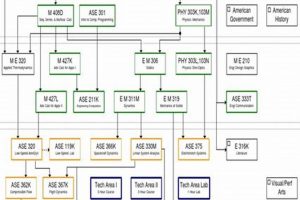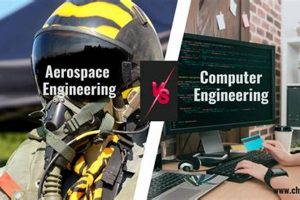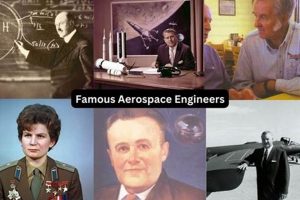Opportunities offering immersive learning experiences within the aeronautics and astronautics fields are valuable for students pursuing careers in these disciplines. These placements provide practical skill development and exposure to real-world engineering challenges. As an example, a structured program at a major aerospace company could involve designing components, analyzing flight data, or contributing to research and development projects.
Engaging in such programs is crucial for career advancement, offering benefits like networking with industry professionals, acquiring specialized knowledge, and enhancing one’s resume. Historically, these experiential learning opportunities have been springboards for graduates to secure full-time positions and become future leaders within the sector. The experiences gained often lead to increased problem-solving abilities and a greater understanding of engineering principles.
The subsequent sections will detail key factors to consider when evaluating potential programs, discuss prominent organizations offering quality training, and provide strategies for securing a placement that aligns with individual career aspirations.
Tips for Securing Optimal Aerospace Engineering Internships
Maximizing the benefits derived from placements within the aerospace engineering sector necessitates a strategic and proactive approach.
Tip 1: Research Potential Employers: Thoroughly investigate companies and organizations aligned with specific interests. Explore their current projects, technological focus, and company culture. For example, if interested in spacecraft propulsion, identify organizations actively involved in that domain.
Tip 2: Tailor Application Materials: Generic resumes and cover letters are unlikely to succeed. Customize these documents to highlight relevant skills and experiences matching the specific requirements of each opportunity. Quantify achievements whenever possible to demonstrate impact.
Tip 3: Network Actively: Attend industry conferences, career fairs, and university events to connect with professionals in the field. Leverage online platforms like LinkedIn to expand the professional network and seek informational interviews. Meaningful connections can provide invaluable insights and potential leads.
Tip 4: Develop Technical Proficiency: Acquire and demonstrate proficiency in relevant software and tools used in aerospace engineering, such as CAD software (e.g., CATIA, SolidWorks), simulation packages (e.g., ANSYS, MATLAB), and programming languages (e.g., Python, C++). Projects showcasing these skills are advantageous.
Tip 5: Cultivate a Strong Academic Record: Maintain a competitive GPA and actively participate in relevant coursework and research opportunities. Strong academic performance is an indicator of commitment and technical aptitude, which is a key factor.
Tip 6: Seek Faculty Mentorship: Engage with professors and academic advisors to gain insights into the field and seek guidance on career paths. They can provide valuable recommendations and assist in identifying suitable placement opportunities.
Tip 7: Prepare for Technical Interviews: Anticipate and practice answering technical questions related to core aerospace engineering principles, such as aerodynamics, structures, and propulsion. Review fundamental concepts and be prepared to solve problems under pressure.
By diligently implementing these strategies, aspiring aerospace engineers can significantly enhance their prospects of securing a rewarding internship experience.
The concluding section will offer resources for identifying suitable internship programs and provide final recommendations for maximizing the professional gains from these experiences.
1. Technical Skill Development
Technical skill development is a cornerstone of effective preparation for a career in aerospace engineering, and highly-rated experiential learning programs are primary vehicles for this development. The acquisition of practical skills, such as proficiency in CAD software, CFD analysis, and materials testing, directly correlates with success in the field. Without sufficient technical expertise, graduates face substantial barriers to entry and career progression. For example, an aeronautical engineering student participating in a program at a leading aerospace manufacturer might develop expertise in designing and analyzing aircraft structures, knowledge that is immediately applicable in a professional setting.
The emphasis on technical skill development within such programs has a cascading effect. Students gain confidence in their abilities, improve their problem-solving capabilities, and become more competitive in the job market. A student, for instance, working on a project involving the optimization of wing designs through computational fluid dynamics (CFD) is not only learning the software but also understanding the underlying aerodynamic principles. This enables them to contribute meaningfully to real-world engineering challenges and makes them an asset to potential employers. Moreover, these programs often offer opportunities to work with cutting-edge technologies and techniques, providing a significant advantage over those who rely solely on theoretical knowledge.
In summary, the focus on improving technical skill sets defines the value proposition of high-quality experiential programs for aerospace engineers. This element is not merely beneficial but essential for career readiness. The challenges inherent in securing a technical role in the aerospace industry are significantly mitigated by the tangible experience and demonstrable competence gained through such opportunities, which provides a pathway towards innovation and leadership within the field.
2. Industry Networking
Industry networking is a critical component of experiential learning within the aerospace engineering domain. Its impact extends beyond the acquisition of technical skills, shaping professional trajectories and facilitating access to career opportunities.
- Building Professional Relationships
Opportunities within well-regarded organizations facilitate interaction with experienced engineers, project managers, and researchers. These interactions enable the formation of professional relationships, offering guidance, mentorship, and potential future collaborations. For instance, participation in a NASA project can expose an intern to engineers involved in cutting-edge research, fostering a network of contacts beneficial for future career prospects.
- Gaining Industry Insights
Networking provides firsthand insights into industry trends, company cultures, and emerging technologies. Conversations with professionals offer perspectives not readily available through academic study. Attending industry conferences or workshops as part of a program enables the acquisition of up-to-date knowledge on industry advancements and challenges.
- Accessing Hidden Job Market
Many employment opportunities are not publicly advertised. Networking provides access to this “hidden job market” through personal referrals and direct connections. Professionals encountered during experiential learning may be aware of upcoming openings or projects aligned with an intern’s skillset, increasing the likelihood of securing a full-time position post-graduation.
- Developing Communication Skills
Interacting with industry professionals necessitates effective communication, both written and verbal. Programs offer opportunities to hone these skills through presentations, technical reports, and team meetings. Clear and concise communication fosters stronger professional relationships and enhances an intern’s ability to collaborate effectively on complex projects.
The network established during these placements serves as a valuable resource throughout an aerospace engineer’s career. These connections provide avenues for career advancement, knowledge sharing, and collaboration on innovative projects, solidifying the importance of strategic networking during formative training experiences.
3. Practical Application
The integration of practical application defines a high-quality experiential learning opportunity within aerospace engineering. The ability to translate theoretical knowledge into tangible results is a critical determinant of success in this field. A program lacking substantive hands-on experience fails to adequately prepare students for the realities of engineering design, analysis, and implementation. For instance, a placement offering the chance to apply aerodynamic principles in the design of a new aircraft wing component represents meaningful practical application. This experience directly enhances the intern’s understanding of how theoretical concepts manifest in real-world engineering challenges.
Further, practical application extends beyond mere execution; it encompasses problem-solving, critical thinking, and adaptation. Consider an example where an intern is tasked with troubleshooting performance issues in a flight simulation model. Successfully addressing this challenge requires applying learned concepts, but also demands creativity and resourcefulness. The ability to diagnose problems, propose solutions, and implement changes effectively demonstrates a genuine grasp of engineering principles. Opportunities to engage in projects that mimic the complexities of actual industry endeavors provide invaluable practical experience.
In summary, the presence of significant practical application distinguishes strong experiential learning programs from weaker alternatives. These opportunities enhance an individual’s skill set and foster a deeper comprehension of engineering concepts. The skills acquired through such programs are directly transferrable to professional roles, facilitating a smoother transition from academia to industry. The practical significance of this element underscores its importance in preparing aspiring aerospace engineers for the challenges and opportunities of their chosen career path.
4. Career Advancement
Career advancement is intrinsically linked to participation in impactful aerospace engineering programs. Such experiential learning opportunities serve as catalysts for professional growth, providing tangible benefits that extend far beyond the duration of the placement. A strategically selected program cultivates the skills, knowledge, and professional network necessary for accelerated career progression. For example, an internship focused on designing propulsion systems equips an individual with specialized expertise, making them a highly sought-after candidate for roles in related fields. This targeted skill development directly translates to increased employability and earning potential. Similarly, exposure to advanced simulation techniques during an experiential placement provides a competitive advantage in the job market, where proficiency in such tools is highly valued.
The connection between these experiential placements and career advancement is further strengthened by the network-building opportunities they provide. Interns interact with industry professionals, mentors, and potential future colleagues, establishing relationships that can open doors to subsequent employment opportunities. These connections offer access to unadvertised positions, internal referrals, and insights into career paths within specific organizations. For instance, an intern who excels in a project and cultivates strong relationships with their team members may be offered a full-time position upon graduation. Furthermore, the experience gained during the placement provides a compelling narrative during job interviews, demonstrating competence, initiative, and a genuine passion for aerospace engineering.
In summary, career advancement is a key outcome associated with high-quality experiential programs within aerospace engineering. These initiatives facilitate skill development, networking, and the acquisition of practical experience, equipping individuals with the tools and connections necessary for accelerated professional growth. The strategic selection of such opportunities represents a significant investment in future career prospects, providing a distinct advantage in a competitive job market and enabling a pathway towards leadership roles within the aerospace industry.
5. Research Exposure
Research exposure, within the framework of optimal experiential learning programs for aerospace engineers, represents a critical avenue for fostering innovation and expertise. Integration into ongoing research projects offers aspiring engineers a unique opportunity to contribute to advancements in the field, fostering intellectual growth and practical acumen.
- Hands-on Experimentation
Participation in research allows interns to engage in hands-on experimentation, working alongside researchers to design, conduct, and analyze experiments. For instance, an intern might contribute to wind tunnel testing of new wing designs, gaining practical experience in data acquisition and analysis. This direct involvement fosters a deeper understanding of the scientific method and enhances problem-solving skills.
- Advanced Technologies Utilization
Exposure to research environments provides access to advanced technologies and equipment not typically available in undergraduate coursework. Interns may utilize sophisticated software for computational fluid dynamics (CFD), finite element analysis (FEA), or control system design. This exposure to state-of-the-art tools broadens their technical skillset and prepares them for advanced roles in industry or academia.
- Contribution to Scientific Literature
In some cases, involvement in research may lead to contributions to scientific publications or presentations at conferences. This provides interns with valuable experience in scientific communication and enhances their credibility within the aerospace community. Authorship or co-authorship on a research paper demonstrates a significant contribution to the field and strengthens their academic profile.
- Development of Critical Thinking Skills
Research inherently demands critical thinking and analytical reasoning. Interns must interpret data, formulate hypotheses, and draw conclusions based on evidence. This process fosters the ability to critically evaluate information, identify limitations, and propose solutions to complex problems, skills that are essential for effective engineering practice.
The research component of a top-tier experiential placement offers a pathway for students to engage directly with the frontier of aerospace knowledge. This immersion provides a level of technical proficiency and critical thinking that distinguishes participants as highly capable and promising contributors to the advancement of aerospace engineering.
6. Project Contribution
Meaningful project contribution stands as a defining characteristic of superior experiential learning programs within the aerospace engineering discipline. These opportunities extend beyond passive observation, requiring participants to actively engage in ongoing projects, thereby fostering skill development and enhancing professional readiness.
- Direct Application of Knowledge
Active involvement in projects necessitates the direct application of academic knowledge to real-world engineering problems. For example, an intern tasked with designing a component for a satellite system must apply principles of structural mechanics, thermodynamics, and materials science. This practical application solidifies theoretical understanding and develops problem-solving skills applicable in a professional setting.
- Teamwork and Collaboration
Projects within aerospace engineering often involve collaboration with multidisciplinary teams. Interns contribute to these teams, interacting with engineers, scientists, and technicians from diverse backgrounds. This fosters communication skills, teamwork, and the ability to effectively contribute to shared project goals, mirroring the collaborative nature of the industry.
- Impact on Project Outcomes
Meaningful project contribution entails making a tangible impact on project outcomes. Interns may contribute to design improvements, efficiency enhancements, or cost reductions. For example, an intern’s analysis might identify an opportunity to optimize a flight trajectory, resulting in significant fuel savings. Such contributions demonstrate competence and value to potential employers.
- Exposure to Engineering Processes
Active project involvement provides exposure to the full spectrum of engineering processes, from conceptual design to testing and validation. Interns gain insights into project management methodologies, quality control procedures, and regulatory compliance requirements. This holistic understanding prepares them for the complexities of engineering practice.
The opportunity to make substantial contributions to ongoing projects is a hallmark of impactful training programs for aspiring aerospace engineers. Such experiences not only enhance technical skills and professional acumen but also increase the likelihood of securing full-time employment and achieving long-term career success within the field.
Frequently Asked Questions About Optimal Experiential Learning Opportunities for Aspiring Aerospace Engineers
This section addresses common inquiries regarding the pursuit and attainment of high-quality experiential placements within the aerospace engineering domain. It aims to clarify misconceptions and provide valuable insights for prospective applicants.
Question 1: What defines a truly “optimal” experiential placement for aerospace engineers?
An optimal placement offers a confluence of technical skill development, industry networking opportunities, practical application of theoretical knowledge, clear avenues for career advancement, significant exposure to research, and tangible project contribution. A program lacking these elements may not provide the comprehensive benefits required for accelerated professional growth.
Question 2: How important are extracurricular activities and personal projects in securing an internship?
Extracurricular activities and personal projects demonstrate initiative, leadership, and a genuine passion for aerospace engineering. Participation in rocketry clubs, drone design competitions, or independent research projects significantly strengthens an application, showcasing skills and commitment beyond academic coursework.
Question 3: What are the most valuable technical skills to emphasize in an application?
Proficiency in industry-standard software such as CAD (e.g., CATIA, SolidWorks), CFD (e.g., ANSYS Fluent), and programming languages (e.g., Python, MATLAB) are highly valued. Demonstrated competence in these tools, through projects or coursework, significantly enhances an applicant’s competitiveness.
Question 4: Is it better to pursue an internship at a large aerospace company or a smaller, more specialized firm?
The ideal choice depends on individual career goals. Large companies offer exposure to a wider range of projects and established processes, while smaller firms often provide more hands-on experience and opportunities for greater impact. Researching the specific offerings and culture of each organization is crucial for making an informed decision.
Question 5: How early should students begin applying for these programs?
The application process can be highly competitive, and many organizations have early deadlines. Students are advised to begin researching and applying for programs as early as their sophomore year, with a focus on securing a placement during their junior or senior year.
Question 6: What steps can students take to improve their chances of receiving an offer?
Students should maintain a strong academic record, develop relevant technical skills, actively participate in extracurricular activities, tailor their application materials to each specific program, and network with industry professionals. Seeking mentorship from faculty members and attending career fairs can also significantly enhance their prospects.
In summary, securing a high-quality experiential opportunity requires proactive planning, strategic skill development, and effective communication of one’s qualifications and career aspirations. A holistic approach, encompassing academic excellence, extracurricular involvement, and targeted networking, is essential for success.
The subsequent sections will provide a consolidated overview of key takeaways and offer final recommendations for maximizing the benefits derived from experiential learning experiences.
Best Internships for Aerospace Engineers
The preceding analysis underscores the paramount importance of strategic participation in the best internships for aerospace engineers. These immersive experiences transcend traditional academic learning, providing avenues for technical skill refinement, professional network development, and practical application of engineering principles. A deliberate approach to selecting placements aligned with individual career aspirations significantly enhances long-term prospects within this competitive field.
Aspiring aerospace engineers are therefore encouraged to prioritize the pursuit of high-quality experiential learning opportunities. The skills and connections cultivated during these formative experiences will serve as a foundation for future innovation and leadership within the aerospace industry. Active engagement in research, meaningful project contributions, and a commitment to continuous learning will ultimately define the trajectory of a successful career in aerospace engineering.







![Top MS Aerospace Engineering in Canada [Guide] Innovating the Future of Flight with Reliable Aviation Solutions Top MS Aerospace Engineering in Canada [Guide] | Innovating the Future of Flight with Reliable Aviation Solutions](https://mixaerospace.com/wp-content/uploads/2025/12/th-715-300x200.jpg)